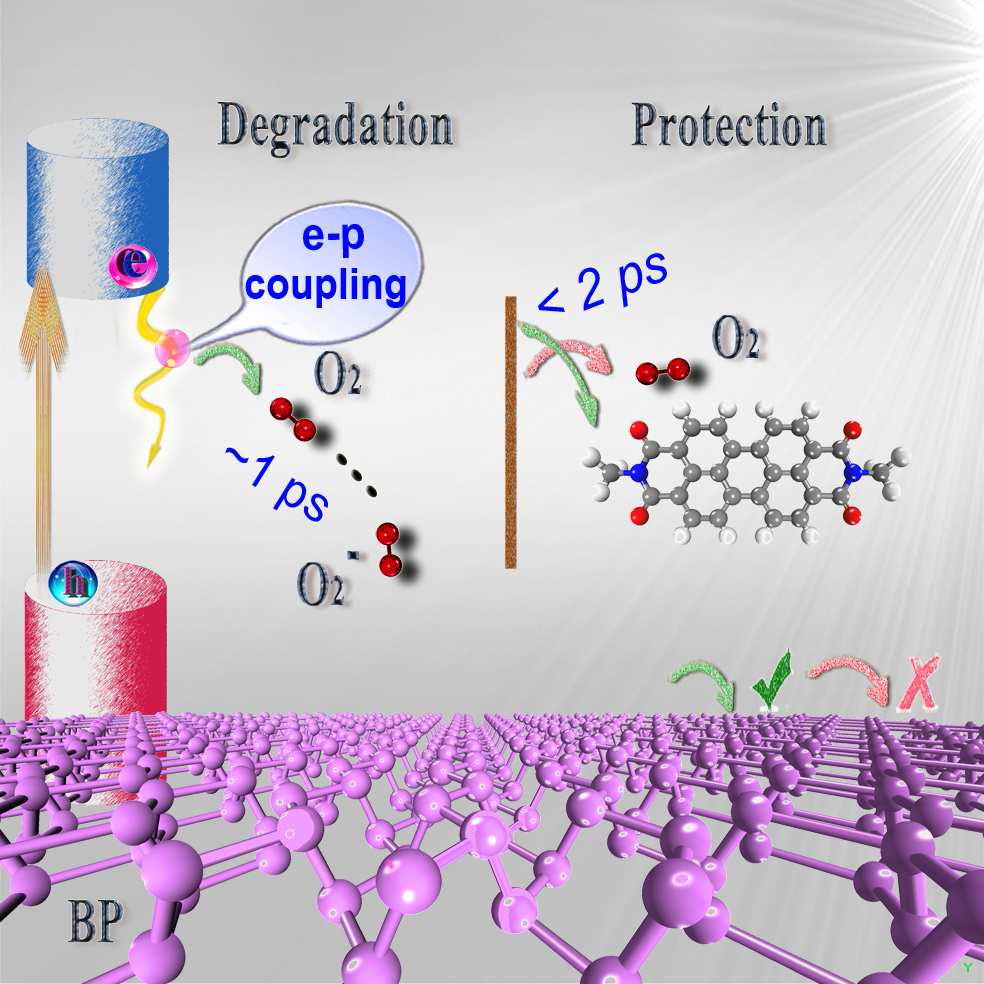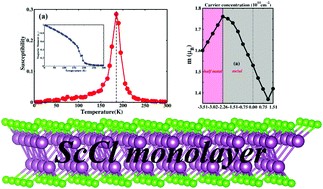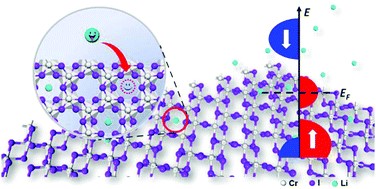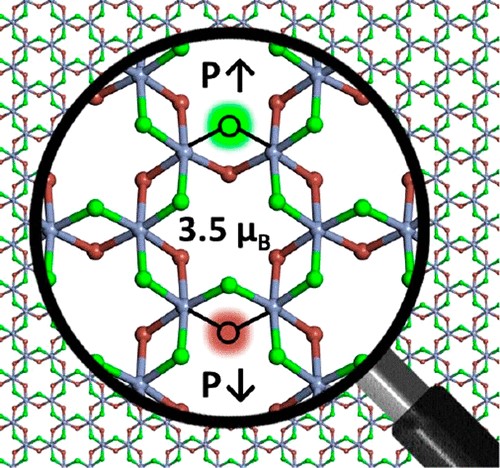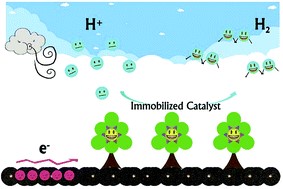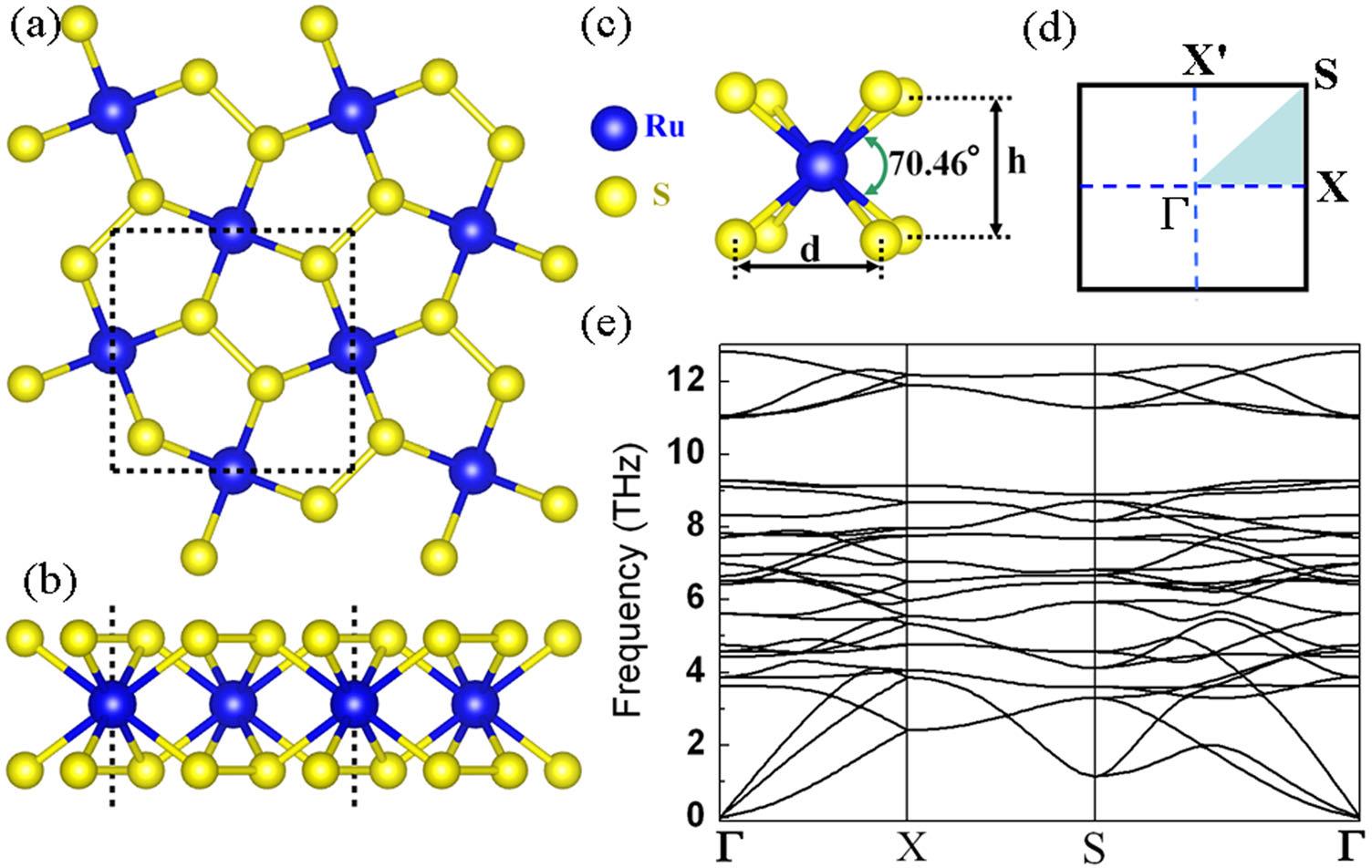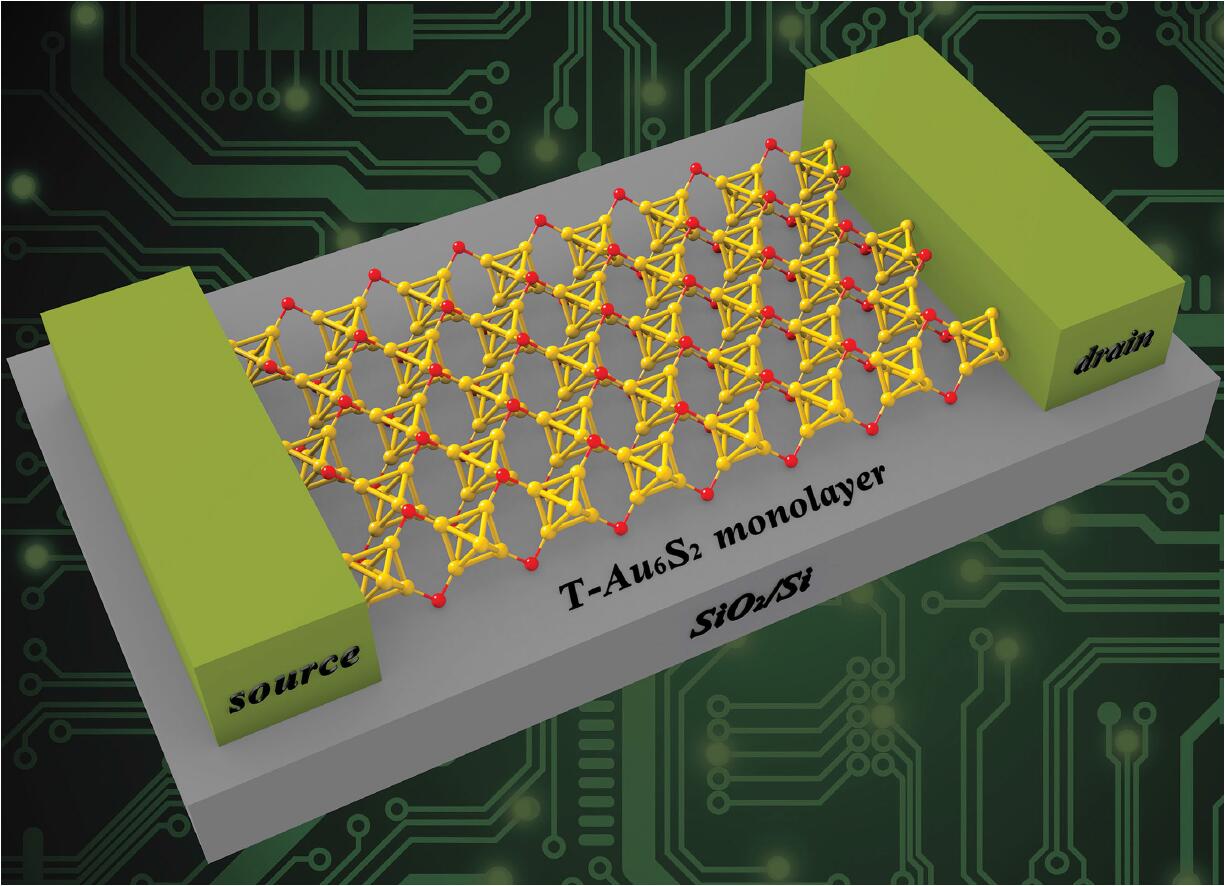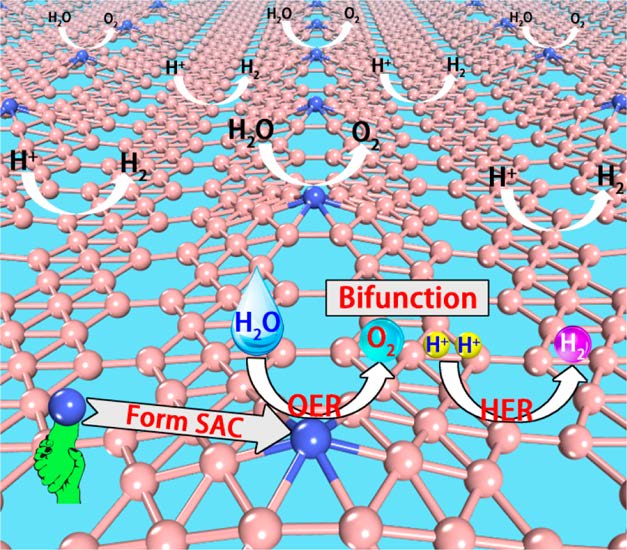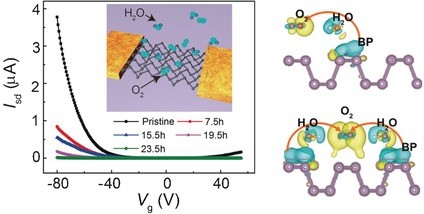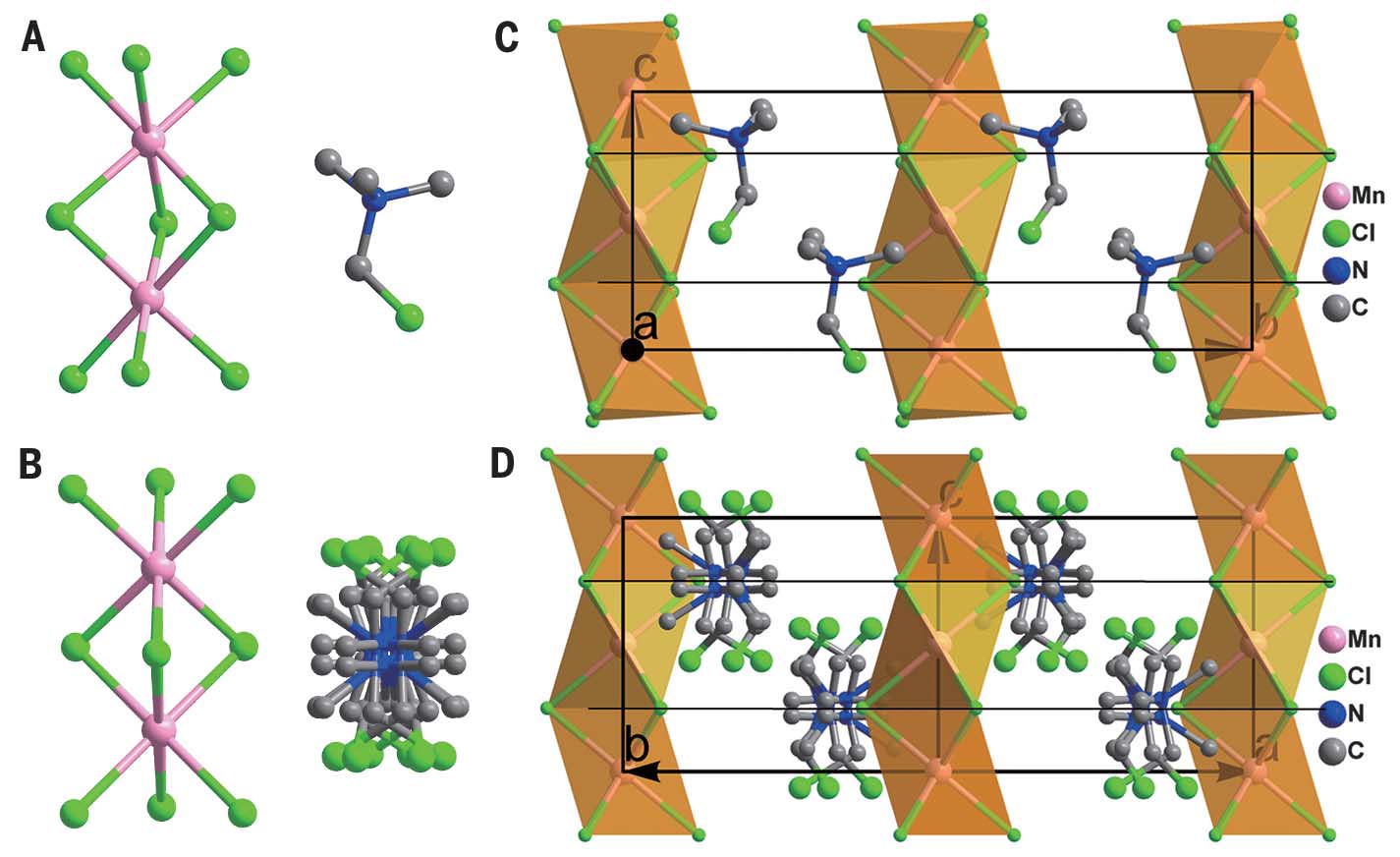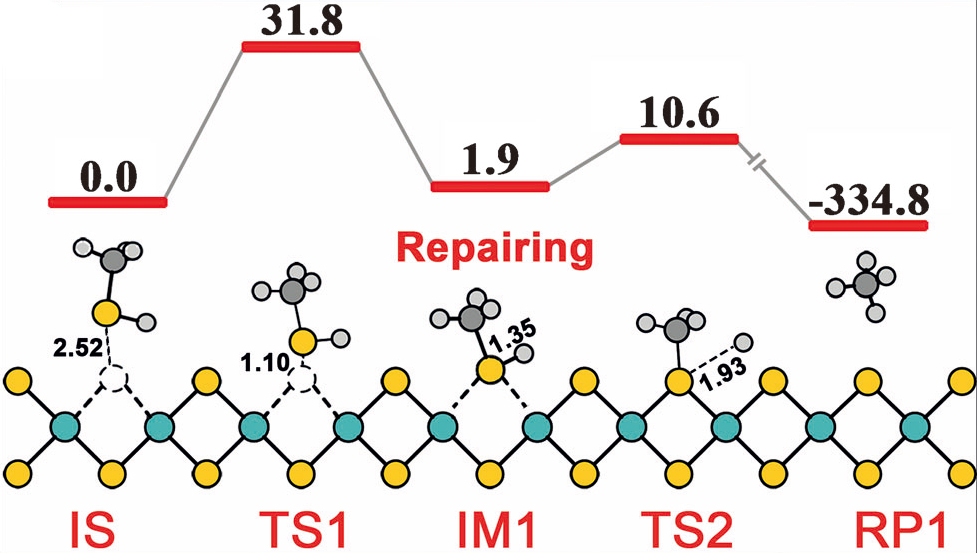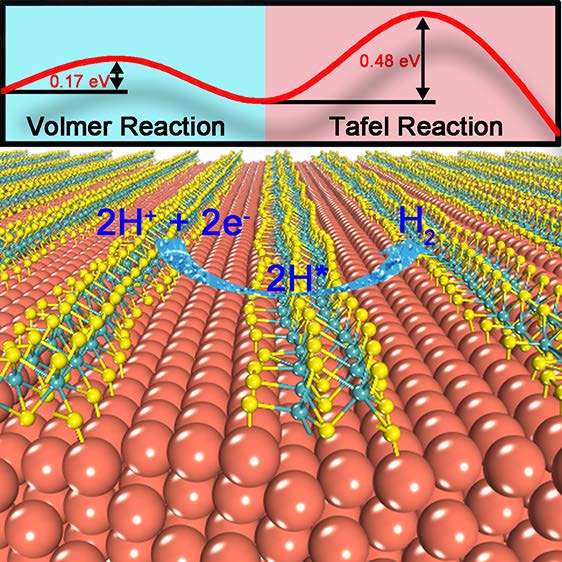The year of 2018
2018.8.7 Congratulations to Dr. Xianghong Niu for his paper entitled "Photo-Oxidative Degradation and Protection Mechanism of Black Phosphorus: Insights From Ultrafast Dynamics" being published in The Journal of Physical Chemistry Letters (J. Phys. Chem. Lett. 2018, DOI: 10.1021/acs.jpclett.8b02060). Highlight: In this work, we carry out time-domain ab initio nonadiabatic molecular dynamics to understand the photogenerated electron dynamics at the molecules/BP interfaces. It is found that oxygen can trap the photogenerated electrons of BP rapidly owing to strong electron-phonon (e-p) coupling and becomes active superoxide under light illumination. This study provides the first in-depth understanding of BP degradation and protection mechanism from excited state dynamics and can be applicable to other 2D photo-oxidative degradation.
2018.7.19 Congratulations to Bing Wang for his paper entitled "High Curie-Temperature Intrinsic Ferromagnetism and Hole Doping-Induced Half-Metallicity in Two-Dimensional Scandium Chlorine Monolayer" being published in Nanoscale Horizons (Nanoscale Horiz. 2018,DOI: 10.1039/C8NH00101D). Highlight: Herein through comprehensive first-principles calculations and Monte Carlo simulation, we predict a promising 2D scandium chlorine (ScCl) monolayer with intrinsic ferromagnetism and a Curie temperature of 185 K. Moreover, a small amount of hole doping can induce a transition from a ferromagnetic metal to a half-metal. These intriguing electronic and magnetic properties make the ScCl monolayer a promising candidate for spintronic applications.
2018.7.13 Congratulations to Qisheng Wu for his paper entitled "Transition Metal Dihydride Monolayers: A New Family of Two-Dimensional Ferromagnetic Materials with Intrinsic Room-Temperature Half-Metallicity" being published in The Journal of Physical Chemistry Letters (J. Phys. Chem. Lett. 2018, 9, 4260-4266). Highlight: Two-dimensional (2D) ferromagnetic materials with intrinsic half-metallicity are highly desirable for nanoscale spintronic applications. Here, we predict a new and stable family of 2D transition-metal dihydride (MH2; M = Sc, Ti, V, Cr, Fe, Co, Ni) monolayers with novel properties. In particular, the CoH2 monolayer is a perfect half-metal with a wide spin gap of 3.48 eV and an above-room-temperature Curie point (339 K). The new family of MH2 monolayers are promising functional materials for spintronic applications due to their novel magnetic properties.
2018.7.9 Congratulations to Chongyi Lingfor his paper entitled "Single Molybdenum Atom Anchored on N-Doped Carbon as a Promising Electrocatalyst for Nitrogen Reduction into Ammonia at Ambient Conditions" being published in Journal of Physical Chemistry C (. J. Phys. Chem. C 2018, 122, 16842-16847). Highlight: The synthesis of NH3 at ambient conditions remains a coveted goal for chemists. We study the potential of the newly synthesized single-atom catalysts, i.e., single metal atoms (Cu, Pd, Pt, and Mo) supported on N-doped carbon for N2 reduction reaction (NRR) by employing first-principles calculations. Our study offers new opportunities for advancing electrochemical conversion of N2 into NH3 at ambient conditions.
2018.5.1 Congratulations to Qisheng Wu for his paper entitled "Two-Dimensional AuMX2 (M=Al, Ga, In; X=S, Se) Monolayers Featuring Intracrystalline Aurophilic Interactions with Novel Electronic and Optical Properties" being published in ACS Applied Materials & Interfaces(ACS Appl. Mater. Interfaces 2018, 10, 16739–16746). Highlight: In this work, we show that aurophilicity can serve as an engineering approach to expand the structural dimensionality for nanomaterials design. Specifically, we predict a series of stable two-dimensional (2D) AuMX2 (M = Al, Ga, In; X = S, Se) structures featuring intracrystalline aurophilic interactions, which render AuMX2 monolayers a potentially new series of 2D materials that are of fundamental importance in gold chemistry and of technological importance for nanoelectronics.
2018.4.25 Congratulations toYilv Guo for her paper entitled "Half-metallicity and enhanced ferromagnetism in Li-adsorbed ultrathin chromium triiodide" being published in Journal of Materials Chemistry C (J. Mater. Chem. C. 2018, 6, 5716-5720). Highlight: Herein, based on first-principles calculations, we show that the CrI3 monolayer can be switched from semiconducting to half-metallicity by lithium atom adsorption. Moreover, the adsorption of Li atoms can further enhance the ferromagnetism of CrI3 sheets by increasing both the magnetic moment and the Curie temperature. The robust half-metallicity together with improved ferromagnetism may open up new promising applications of CrI3-based materials in spintronics.
2018.4.18 Congratulations to Dr.YInghe Zhao for his paper entitled "Surface Vacancy-Induced Switchable Electric Polarization and Enhanced Ferromagnetism in Monolayer Metal Trihalides" being published in Nano Letters (Nano Lett. 2018, 18, 2943-2949). Highlight: Atom-thick 2D materials with switchable electric polarization are now urgently needed for their rarity and important roles in nanoelectronics. We unveil that surface I vacancies not only enhance the intrinsic ferromagnetism of monolayer CrI3 but also induce switchable electric polarization. This work opens up a new and general way toward pursuing low-dimensional multifunctional nanodevices.
2018.1.17 Congratulations to Dr. Qiang Li for his paper entitled "On-surface synthesis: a promising strategy toward the encapsulation of air unstable ultra-thin 2D materials" being published in Nanoscale (Nanoscale 2018, 10, 3799-3804 ). Highlight: Herein, the on-surface growth of an oxidation-resistant 2D thin film of a metal coordination polymer is demonstrated by multiscale simulations. Our facile strategy for enhancing the environmental stability of ultrathin materials is expected to accelerate efforts to implement 2D materials in electronic and optoelectronic applications.
2018.1.11 Congratulations to Bing Wang for his paper entitled "Ultrathin Semiconducting Bi2Te2S and Bi2Te2Se with High Electron Mobilities" being published in The Journal of Physical Chemistry Letters (J. Phys. Chem. Lett. 201, 9, 487-490). Highlight: Two ultrathin two-dimensional (2D) semiconductors, namely, Bi2Te2S and Bi2Te2Se nanosheets are predicted to own moderate band gaps (~0.7 eV) and high electron mobilities (∼20 000 cm2/Vs), and they can absorb sunlight efficiently through the whole incident solar spectrum. The exceptional properties render Bi2Te2X (X = S, Se) monolayers promising candidates in future high-speed (opto)electronic devices.
2018.1.1 Congratulations toYixin Ouyang for his paper entitled "Molybdenum sulfide clusters immobilized on defective graphene: a stable catalyst for the hydrogen evolution reaction" being published in Journal of Materials Chemistry A (J. Mater. Chem. A 2018, 6, 2289-2294 ). Highlight: We have designed a novel composite catalyst, which is composed of molybdenum sulfide clusters and defective graphene, holding excellent intrinsic activity, high-density active sites and high conductivity simultaneously.
The year of 2017
2017.11.21 Congratulations to Xianghong Niu for his paper entitled "Arsenene-Based Heterostructures: Highly Efficient Bifunctional Materials for Photovoltaics and Photocatalytics" being published in ACS Applied Materials & Interfaces (ACS Appl. Mater. & Interfaces 2017, 9, 42856-42861). Highlight: On the basis of accurate band structure calculations by combining the many-body perturbation GW method with an extrapolation technique, we demonstrate that arsenene-based heterostructures paired with molybdenum disulfide, tetracyano-quinodimethane, or tetracyanonaphtho-quinodimethane can form type II band alignments. These arsenene-based heterostructures cannot only satisfy all the requirements as photocatalysts for photocatalytic water splitting but can also show an excellent power conversion efficiency of ∼20% as potential photovoltaics.
2017.10.9 Congratulations to Dr. Qionghua Zhou for his paper entitled "Band-edge engineering via molecule intercalation: a new strategy to improve stability of few-layer black phosphorus" being published in Physical Chemistry Chemical Physics (Phys. Chem. Chem. Phys. 2017, 19, 29232-29236). Highlight: Our first-principles calculations demonstrate that enlarging the interlayer spacing can effectively shift the conduction band minimum down to suppress the generation of superoxide and the enlargement can be achieved by intercalating small molecules like H2 and He into BP. Moreover, the molecule intercalated BP maintains high hole mobility, which makes it a better two-dimensional semiconductor for practical applications.
2017.9.23 Congratulations to Yinghe Zhao for his paper entitled "Exploitation of the Large‐Area Basal Plane of MoS2 and Preparation of Bifunctional Catalysts through On‐Surface Self‐Assembly" being published in Advanced Science (Adv. Sci. 2017, 4, 1700356). Highlight: In this work, on‐surface self‐assembly is demonstrated to be an effective, facile, and damage‐free method to take full advantage of the large ratio surface of MoS2 for HER by using multiscale simulations, which opens up a new and promising avenue (on‐surface self‐assembly) toward the full exploitation of the basal plane of MoS2 for HER and the preparation of bifunctional catalysts for overall water splitting.
2017.9.11 Congratulations to Dr. Shijun Yuan for his paper entitled "Prediction of a room-temperature eight-coordinate two-dimensional topological insulator: penta-RuS4 monolayer" being published in npj 2D Materials and Applications (npj 2D Mater. Applications 2017, 1, 29). Highlight: We predict a stable eight-coordinate two-dimensional RuS4 monolayer, with a trilayer S–Ru–S and pentagonal rings tiling configuration by first-principles calculations. This monolayer exhibits unique anisotropic quadratic energy dispersion with two Dirac points emerging at the high-symmetric Γ point.
2017.8.28 Congratulations to Li Shi for his paper entitled "Oxidation Mechanism and Protection Strategy of Ultrathin Indium Selenide: Insight from Theory" being published in The Journal of Physical Chemistry Letters (J. Phys. Chem. Lett. 2017, 8, 4368). Highlight: This study provides a profound understanding of the degradation mechanism of InSe via in-air oxidation and opens a possible route to stabilize InSe against ambient. We expect that this detailed study also provides ideas for the universal degradation problem existing in 2D materials.
2017.8.22 Congratulations to Qisheng Wu for his paper entitled "Au6S2 monolayer sheets: metallic and semiconducting polymorphs" being published in Materials Horizons (Mater. Horiz. 2017, 4, 1085-1091 ). Highlight: We predicts G- and T-Au6S2 monolayers, whose properties render them promising materials for advanced applications in microelectronics and optoelectronics. This work is selected as inside back cover in issue 6, 2017.
2017.7.26 Congratulations to Chongyi Ling for his paper entitled "Nanosheet Supported Single-Metal Atom Bifunctional Catalyst for Overall Water Splitting" being published in Nano Letters (DOI: 10.1021/acs.nanolett.7b02518). Hihglight: The desired nanosheet supported single-atom bifunctional catalysts not only show great potential for achieving overall water splitting but also offer cost-effective opportunities for advancing clean energy technology.
2017.7.24 Congratulations to Dr. Qiang Li for his paper entitled "Water‐Catalyzed Oxidation of Few‐Layer Black Phosphorous in a Dark Environment" being published in Angewandte Chemie (Angew. Chem. Int. Ed. 2017, 129, 9259-9263). Highlight: To date, it is generally accepted that BP degrades in air via light‐induced oxidation. Herein, we report a new degradation channel via water‐catalyzed oxidation of BP in the dark. This new degradation mechanism lays important foundation for the development of proper protecting schemes in black phosphorus‐based devices.
2017.7.20 Congratulations to Dr. Qionghua Zhou andXianghong Niu for their contributions to research paper entitled "An organic-inorganic perovskite ferroelectric with large piezoelectric response" being published in Science (Science, 2017, 357, 306-309). Highlight: This work shows that trimethylchloromethyl ammonium trichloromanganese(II), an organic-inorganic perovskite ferroelectric crystal processed from aqueous solution, has a large d33 of 185 picocoulombs per newton and a high phase-transition temperature of 406 kelvin (K) (16 K above that of BTO). This makes it a competitive candidate for medical, micromechanical, and biomechanical applications.
2017.7.4 Congratulations to Dr. Qiang Li for his paper entitled "Towards a Comprehensive Understanding of the Reaction Mechanisms Between Defective MoS2 and Thiol Molecules" being published in Angewandte Chemie (Angew. Chem. Int. Ed. 2017, 56, 1-6). Highlight: This study fosters a way of precisely tailoring the electronic and optical properties of MoS2 by means of thiol chemistry approaches.
2017.6.14 Congratulations to Chongyi Ling for his paper entitled "Template-Grown MoS2 Nanowires Catalyze the Hydrogen Evolution Reaction: Ultralow Kinetic Barriers with High Active Site Density" being published in ACS Catalysis (ACS Catal., 2017, 7, pp 5097–5102). Highlight: This work provides a possible way to achieve the ultrahigh HER activity of MoS2-based catalysts..
2017.3.29 Congratulations to Bing Wang for his paper entitled "A new Dirac cone material: a graphene-like Be3C2 monolayer" being published in Nanoscale.
2017.3.20 Congratulations to Xiaojing Yao for her paper entitled "Theoretical study on the self-assembly of 1,3,5-triethynylbenzene on Si(100)2*1 and in situ polymerization via reaction with CO to fabricate a single surface-grafted polymer" being published in Journal of Materials Chemistry C.
2017.2.27 Congratulations to Prof. Wang for being elected one of China's Most Cited Researchers (2016).
2017.2.14 Congratulations to Yinghe Zhao for his paper entitled "How To Obtain High-Quality and High-Stability Interfacial Organic Layer: Insights from the PTCDA Self-Assembly" being published inThe Journal of Physical Chemistry C.
2017.1.24 Congratulations to Xianghong Niu for his paper entitled "Efficient Carrier Separation in Graphitic Zinc Oxide and Blue Phosphorus van der Waals Heterostructure" being published inThe Journal of Physical Chemistry C.
2017.1.11 Congratulations to Dr. Qionghua Zhou for his paper entitled "Dielectric and ferroelectric sensing based on molecular recognition in Cu(1,10-phenlothroline)2SeO4(diol)systems" being published in Nature Communications under coorperation with experimental group (Nat. Commun. 2017, 8, 14551). This finding shows that dielectricity and/or ferroelectricity has the potential to be used for signalling molecular recognition.
The year of 2016
2016.12.14 Congratulations to Xianghong Niu for his paper entitled "Photoabsorption Tolerance of Intrinsic Point Defects and Oxidation in Black Phosphorus Quantum Dots" being published inThe Journal of Physical Chemistry Letters.
2016.12.14 Congratulations to Yinghe Zhao for his paper entitled "Passivation of Black Phosphorus via Self-Assembled Organic Monolayers by van der Waals Epitaxy" being published in Advancend Materials.
2016.12.6 Congratulations to Li Shi and Chongyi Ling for their paper entitled "High Intrinsic catalytic activity of two-dimensional boron monolayers for the hydrogen evolution reaction" being published in Nanoscale.
2016.11.28 Congratulations to Chongyi Ling for his paper entitled "Searching for Highly Active Catalysts for Hydrogen Evolution Reaction Based on O-Terminated MXenes through a Simple Descriptor" being published in Chemistry of Materials.
2016.10.29 Congratulations to Qiang Li for his paper entitled "Covalent Functionalization of Black Phosphorus from First-Principles" being published in The Journal of Physical Chemistry Letters.
2016.10.20 Congratulations to Xianghong Niu for his paper entitled "Revealing the underlying absorption and emission mechanism of nitrogen doped graphene quantum dots" being published in Nanoscale.
2016.10.13 Congratulations to Xiaojing Yao for her paper entitled "How to Fabricate a Surface-Grafted Polythiophene on H-Si(100)2*1 Surface via Self-Assembling and in Situ Surface Polymerization: A Theoretical Guide" being published in Journal of Physical Chemistry C.
2016.9.8 Congratulations to Qisheng Wu for his paper entitled "Versatile Titanium Silicide Monolayers with Prominent Ferromagnetic, Catalytic and Superconducting Properties: Theoretical Prediction" being published in The Journal of Physical Chemistry Letters (IF=8.539).
2016.8.29 Congratulations to Qionghua Zhou for his paper entitled "Te-Doped Black Phosphorus Field-Effect Transistors" being published in Advanced Materials (IF=18.960) as equally contributing first author under coorperation with experimental group..
2016.8.25 Dr. Liang Ma's Ph.D thesis "The Growth Mechanisms, Controllable Syntheses and Molecular Designes of Graphene Nanostructures" was elected as Excellent Ph.D Thesis of Jiangsu Province in 2016. Congratulations!!!
2016.8.16 Qionghua Zhou published an important research paper entitled "Light-Induced Ambient Degradation of Few-Layer Black Phosphorus: Mechanism and Protection" in Angewandte Chemie (IF=11.709). Congratulations!!!
2016.7.15 Xiaojing Yao published a research paper entitled "tructure and electronic properties of bilayer graphene functionalized with half-sandwiched transition metal-cyclopentadienyl complexes" in Physical Chemistry Chemical Physics (IF=4.449). Congratulations!
2016.7.15 Congratulations to Yixin Ouyang for winning Excellent Poster Award in 30th Academic Annual Conference of Chinses Chemical Society.
2016.6.28 Congratulations to Chongyi Ling for publishing paper entitled "Transition Metal-Promoted V2CO2 (MXenes): A New and Highly Active Catalyst for Hydrogen Evolution Reaction" in Advanced Science.
2016.6.2 Congratulations to Dr. Liyan Zhu for publishing a research paper entitled "The Great Reduction of a Carbon Nanotube’s Mechanical Performance by a Few Topological Defects" in ACS Nano (IF=13.334).
2016.6.1 Qisheng Wu recieved financial support from Chinese Scholarship Council (CSC). He is going to study in Dr. Xiaocheng Zeng's group in Department of Chemistry, University of Nebraska-Lincoln for the next two years.
2016.5.27 Yixin Ouyang published a paper entitled "Activating Inert Basal Planes of MoS2 for Hydrogen Evolution Reaction through the Formation of Different Intrinsic Defects" in Chemistry of Materials (IF=9.407). Congratulations!!!
2016.5.16 As equally contributing first author, Yinghe Zhao published a paper entitled "Precise, Self-Limited Epitaxy of Ultrathin Organic Semiconductors and Heterojunctions Tailored by van der Waals Interactions" in Nano Letters (IF=13.779). Congratulations!
2016.5.4 Dr. Huabing Shu published a paper entitled "Greatly Enhanced Optical Absorption of Defective MoS2 Monolayer through Oxygen Passivation" in ACS Applied Materials & Interfaces (IF=7.145).
2016.3.16 Xiaojing Yao published a paper entitled "Theoretical Studies of Sandwich Molecular Wires with Europium and Boratacyclooctatetraene Ligand and the Structure on a H‑Ge(001)-2×1 Surface" in The Journal of Physical Chemistry C (IF=4.509).
2016.1.26 Congratulations to Huabing Shu for publishing paper entitled "The Stacking Dependent Electronic Structure and Optical Properties of Bilayer Black Phosphorus" in Physical Chemistry Chemical Physics (IF=4.449).
2016.1.22 Dr. Qian Chen and Dr. Liang Ma published a review article entitled "Making graphene nanoribbons: a theoretical exploration" in WIRES Computational Molecular Science. Congratulations to them!
2016.1.10 Xianghong Niu published a research paper entitled "Anomalous Size Dependence of Optical Properties in Black Phosphorus Quantum Dots" in The Journal of Physical Chemistry Letters (IF=8.539). Congratulations!!!
2016.1 Congratulations to Yixin Ouyang for winning the third prize of Excellent Diploma Projects of Universities in Jiangsu Province under supervision of Prof. Jinlan Wang !!! (2015)

